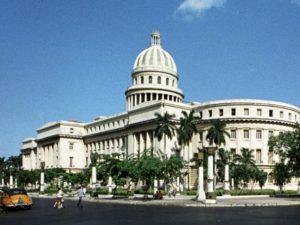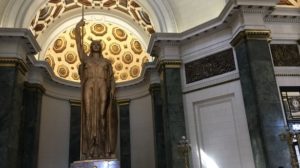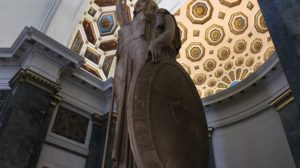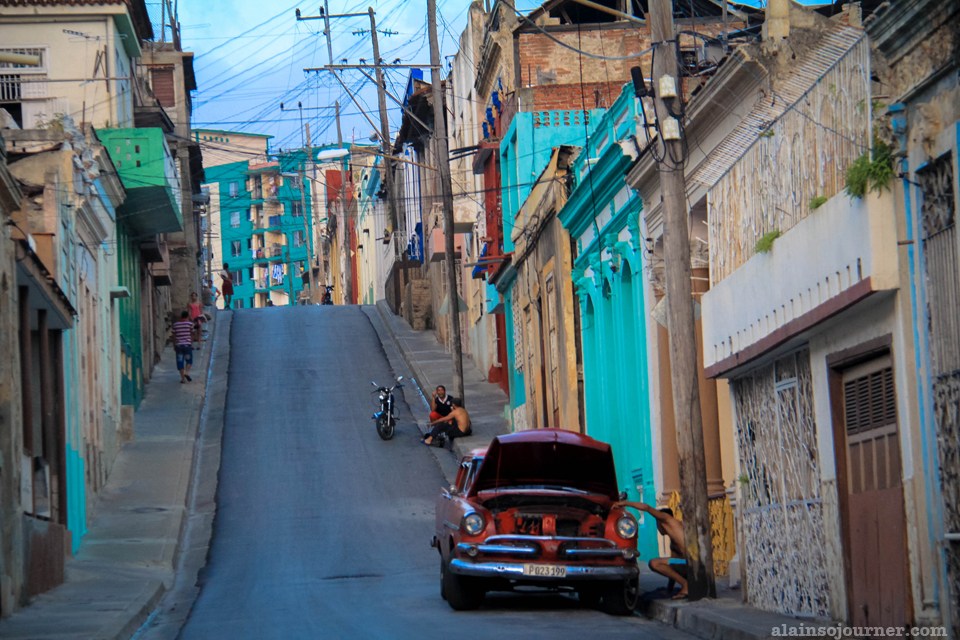EL CAPITOLIO CUBANO ABRE DE NUEVO SUS PUERTAS. FOTOS.
Las personas que esta semana llegan al Capitolio con el interés de visitar sus salones ya restaurados son recibidos por un guardia de seguridad que desde la escalinata les indica con el dedo el sitio donde comienza el recorrido. Algunos hacen caso pero otros no quieren visitar el monumento y se conforman con hacerse una fotografía en la entrada.
El custodio que da la bienvenida por el costado izquierdo de la escalinata no explicaba con claridad el mecanismo de las visitas. Las visitas siempre son guiadas y se organizan en cuatro grupos de quince personas con guías en español y en inglés.
Antes de comenzar el recorrido, la guía advierte de que, por cuestiones de seguridad, solo se pueden hacer fotos y vídeos en el Salón de los Pasos Perdidos y en la Cripta del Mambí Desconocido.
El Capitolio fue construido por el Ministerio de Obras Públicas del Gobierno de Gerardo Machado, entre 1926 y 1929, y una vez inaugurado acogió las dos cámaras. Después de 1959, sus amplios salones sirvieron durante décadas tanto a la Academia de Ciencias como al Ministerio de Ciencia, Tecnología y Medio Ambiente (Citma).
Según la guía, la previsión es que la restauración total del edificio concluya el 16 de noviembre de 2019 “coincidiendo con el 500 aniversario de la fundación de la villa de San Cristóbal”.
El Capitolio, que pasó en 2010 a la Oficina del Historiador de La Habana, tiene “grado patrimonial 1”, por lo que está prohibido “levantar los pisos, hacer ranuras en las paredes o cambiar algo de lo que originalmente estaba”. Para el trabajo en yeso de sus techos se requirió a 400 profesionales.
La cúpula tiene 91,73 metros y es el segundo punto más alto de la ciudad. El primero es el obelisco de la Plaza de la Revolución. La bóveda tiene como referentes la de la basílica de San Pedro, en Roma, y otros templos de Londres o París.
En uno de los patios interiores, que no forma parte del recorrido, se levanta sobre un pedestal de mármol una estatua llamada ‘El Ángel Rebelde’, inspirada en Lucifer. Creada por el escultor de origen italiano Salvatore Bohemi, es de las pocas en el mundo que alude a Satanás.
En el salón Yara no se puede hacer fotografías. Allí se muestra una exhibición de la vajilla y los cubiertos originales del Capitolio, fabricados en la primera mitad del siglo XX, y que fueron encargados en casas prestigiosas de la época, como Tiffany’s. La vajilla lleva el sello con las siglas RC (República de Cuba), que también se pueden ver en sus techos.
El Salón de los Pasos Perdidos está presidido por la majestuosa estatua de La República, del escultor y arquitecto italiano Angelo Zanelli. La obra está inspirada en la diosa Palas Atenea y la modelo era cubana.
En su escudo la escultura porta el emblema nacional cubano y lleva tallados algunos relieves que simbolizan eventos importantes de la historia nacional. Esculpida en Nápoles (Italia) y con 17,5 metros y 49 toneladas, la obra descansa sobre una base de mármol ónix de Egipto.
Una réplica del diamante original del Capitolio, que se dice que está guardado en las bóvedas del Banco Central de Cuba, se ha colocado después de la restauración en el punto que marca el kilómetro cero de la carretera central. La piedra preciosa original tenía 25 quilates y según la creencia popular adornaba una de las coronas del último zar ruso, Nicolás II. Fue traído a Cuba por un joyero turco y comprado a través de una ponina realizada por los propios trabajadores del Capitolio.
Varios relieves de las puertas de la entrada aluden a conceptos como el pensamiento, el estudio, el trabajo, la música o la danza. En algunos de ellos se pueden ver los rostros de los presidentes que gobernaron la República hasta el momento de la construcción del Capitolio. En la huelga de 1933 parte de la población borró la cara de Gerardo Machado, además de la fecha de su periodo de gobierno (1925-1933) y su nombre.
Los trabajos de restauración continúan en la parte sur del Capitolio y en la cúpula. En algunas zonas del interior del edificio se pueden ver andamios y hombres trabajando.
Durante el recorrido se explica que en la escalinata hay dos estatuas del escultor italiano Angelo Zanelli. Una de las figuras es masculina y se titula ‘El Trabajo’, que de manera alegórica representa “el progreso de la actividad humana”. La otra pieza, titulada ‘La Virtud Tutelar’, representa a una mujer en alusión a “la virtud tutelar del pueblo”.
La visita termina en la cripta que guarda los restos del Mambí Desconocido y que rinde honor a aquellos que lucharon por la independencia de Cuba. A su alrededor están las banderas de todas las naciones del continente americano así como la escultura de La Patria, la partitura original del himno nacional y el escudo de la República en armas, que sirvió durante las guerras contra España.
THE CUBAN CAPITOL OPENS ITS DOORS AGAIN. PHOTOS.
The people who arrive at the Capitol this week with the interest of visiting their already restored halls are greeted by a security guard who from the stairway indicates with their finger where the journey begins. Some are paying attention but others do not want to visit the monument and they are content to take a photograph at the entrance.
The custodian who welcomes on the left side of the staircase did not clearly explain the mechanism of the visits. The visits are always guided and organized in four groups of fifteen people with guides in Spanish and English.
Before starting the tour, the guide warns that, for security reasons, only photos and videos can be taken in the Hall of the Lost Steps and in the Crypt of the Unknown Mambí.
The Capitol was built by the Ministry of Public Works of the Government of Gerardo Machado, between 1926 and 1929, and once opened it hosted the two chambers. After 1959, its large rooms served for decades both the Academy of Sciences and the Ministry of Science, Technology and Environment (Citma).
According to the guide, the forecast is that the total restoration of the building will conclude on November 16, 2019 “coinciding with the 500th anniversary of the founding of the town of San Cristóbal”.
The Capitol, which happened in 2010 to the Office of the Historian of Havana, has “patrimonial degree 1”, so it is forbidden to “raise the floors, make slots in the walls or change something of what was originally”. For the plaster work on their roofs, 400 professionals were required.
The dome measures 91.73 meters and is the second highest point in the city. The first is the obelisk of the Plaza de la Revolución. The vault has as referents the one of the basilica of San Pedro, in Rome, and other temples of London or Paris.
In one of the inner courtyards, which is not part of the route, a statue called ‘The Rebel Angel’, inspired by Lucifer, stands on a marble pedestal. Created by the Italian-born sculptor Salvatore Bohemi, it is one of the few in the world that alludes to Satan.
In the Yara room you can not take pictures. There is an exhibition of the original cutlery and crockery of the Capitol, manufactured in the first half of the 20th century, and commissioned in prestigious houses of the time, such as Tiffany’s. The dishes are stamped with the initials RC (Republic of Cuba), which can also be seen on their ceilings.
The Hall of the Lost Steps is presided over by the majestic statue of the Republic, by the Italian sculptor and architect Angelo Zanelli. The work is inspired by the goddess Palas Athena and the Cuban era model.
In its shield, the sculpture carries the Cuban national emblem and has carved some reliefs that symbolize important events of national history. Sculpted in Naples (Italy) and with 17.5 meters and 49 tons, the work rests on a base of onyx marble from Egypt.
A replica of the original diamond of the Capitol, which is said to be kept in the vaults of the Central Bank of Cuba, has been placed after the restoration at the point that marks the zero kilometer of the central highway. The original gemstone was 25 carats and according to popular belief adorned one of the crowns of the last Russian tsar, Nicholas II. It was brought to Cuba by a Turkish jeweler and bought through a poncho made by the workers of the Capitol.
Several reliefs on the entrance doors allude to concepts such as thought, study, work, music or dance. In some of them you can see the faces of the presidents who governed the Republic until the time of the construction of the Capitol. In the strike of 1933 part of the population erased the face of Gerardo Machado, in addition to the date of his term in office (1925-1933) and his name.
Restoration work continues in the southern part of the Capitol and in the dome. In some areas of the interior of the building you can see scaffolding and men working.
During the tour it is explained that on the staircase there are two statues of the Italian sculptor Angelo Zanelli. One of the figures is masculine and is titled ‘The Work’, which allegorically represents “the progress of human activity”. The other piece, titled ‘The Tutelary Virtue’, represents a woman in allusion to “the tutelary virtue of the people”.
The visit ends in the crypt that keeps the remains of the Unknown Mambí and that honors those who fought for the independence of Cuba. Around it are the flags of all the nations of the American continent as well as the sculpture of La Patria, the original score of the national anthem and the coat of arms of the Republic, which served during the wars against Spain.
Agencies/14ymedio,La Habana/Internet Photos/Arnoldo Varona/TheCubanhistory.com
THE CUBAN HISTORY, HOLLYWOOD.












